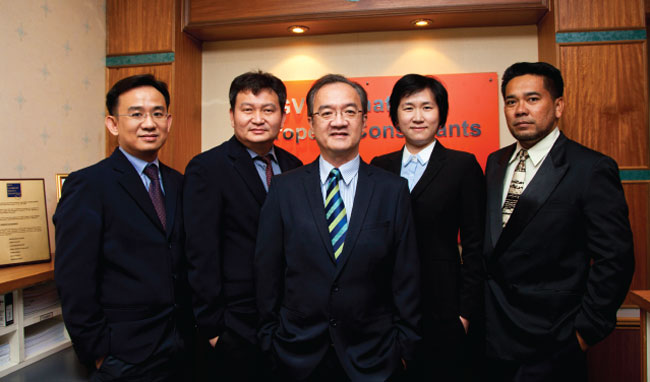Property Trend in Johor Bahru
KGV International Property Consultants ( KGV) started its operation in 1974 in Kuala Lumpur. It was then known as KGV & Associates Sdn Bhd, reflecting its association with the Dutch Property Consultancy Group.
In 1987, KGV opened its first branch in Johor Bahru. Started humbly with only 4 staff in Kompleks Tun Abdul Razak, it has since grown to a staff force of about 30. Today the JB office has 5 registered valuers offering a wide range of valuation services for financing, foreclosure, civil suits, taxation, land acquisition, merger & acquisition, appraisal of properties for initial public listing offering in the Bursa Malaysia and other accounting purposes. Apart from the valuation department, it also has an Auction Department that undertakes judicial and non- judicial auctions. KGV is known for its research and consultation department having undertaken major assignments to ascertain the viability and master planning of some significant projects for both local and overseas clients.
KGV features regularly in business dailies and in the media on property matters. The director headed by Sr Samuel Tan is a regularly speaker in various conferences.
The Marketing Department is actively engaged in the sales, purchase and rental of properties. In fact KGV was known in the region for a couple of significant transactions. It won several top awards in the Danaharta’s sale of properties. It also successfully sold Plaza Best World, Menara Landmarks, assets of Aiwa and hundreds of acres of industrial and development lands.
Trends in the Johor Bahru’s property market
This can be categorized into several phases, each with its unique characteristics evolved from the advents of the different eras.
1980s setting
In the 1980s, the property market was simple with developments largely monopolized by several large companies. Among them are Pelangi Sdn Bhd which developed Taman Pelangi and Taman Perling. Daiman Development Sdn Bhd was the developer for Taman Sentosa, Taman Sri Skudai and Taman Johor Jaya. Century Development Sdn Bhd was instrumental for Century Garden. The MBf Group was another active group with Taman Desa Jaya, Taman Megah Ria and others in their belt. UMLand was behind Bandar Seri Alam. Johor Land was the principal developer for Taman Cempaka, Taman Melur and others in the Pasir Gudang and Tampoi regions.
Prices of single-storey and double -terrace houses were about RM80,000 and RM110,000 respectively. Similarly, single-storey and double-storey semi -detached houses were transacted at about RM115,000 and RM250,000 respectively.
The recession in the mid-80s casted a shadow over the economy of the state and it also affected the property market. However this quickly recovered until the imposition of the RM100,000 levy on sale to foreign purchasers. This policy had the infamous implication of frightening foreigners from investing in Malaysia. It was seen as a detrimental policy as it casted fear on the ‘flip flop’ policy of the government.
1990s setting
Between the years 1990 to 2000, we saw the entry of several Klang Valley developers such as SP Setia, Mah Seng Properties Sdn Bhd and Plenitude Sdn Bhd. Some of the local estate owners converted their plantations into housing schemes. Among them are the Crescendo Group, IOI and the Genting Group. More players started to emerge including Scientex, Country View, Focus Aim and UDA. This phase also witnessed the massive acquisition of some 24,000 acres of land in the present Nusajaya to create a new township to complement the new Second Link.
Property prices started to recover from the mid-80s downturn. It gradually peaked around 1996/97. That was also the period where Malaysia’s economy was doing well. It had been transformed from a agro-based economy into an industrial based with many MNCs investing here. Johor Bahru saw a major transformation with many industrial estates, both public and private mushrooming during this period. This gave rise to employment opportunities and in-migration from other parts of Malaysia.
In 1998, there was the Asian Financial Crisis which shattered the momentum built in the property market over the last 10 years. At the peak, property prices dropped as much as 25%. This continued until 1999 whereby uncertainties could be felt in the market.
2000s setting
The year 2000 was the beginning of a dramatic recovery after 2 years of slump. There was renewed confidence causing property developers to launch new products. Prices also moved northwards, albeit cautiously. This trend continued for the following 3 years. 2003 saw the effects of SARS in the region and its detrimental effects on almost all sectors of the economy.
To stimulate demand, the government waived stamp duty for properties valued at RM180,000 each and below from the second half of 2004 till the first half of 2005. This pro-active move immediately witnessed a rise in the transaction volume. However, prices in general remained flattish and this remained so for the following few years.
The formation of the then South Johor Economic Region (SJER) in November 2006 was a major milestone in Johor Bahru. Covering an area of about 2,217 sq km involving 5 local councils, this economic was formed to transform the southern region of Johor into a major metropolis. It has 5 flagship zones, each with focused activities. Zone A is the Johor Bahru city centre with emphasis on financial activities, waterfront living, urban tourism and heritage district. Zone B is the Nusajaya region where 8 signature projects were initiated. They are Kota Iskandar (the new State Administrative Centre), Puteri Harbour, Educity, Afiat Healthpark, Nusajaya Residences, Southern Integrated Logistics Clusters (SiLC, a managed industrial park), Medini City and International Destination Resort.
SJER was subsequently renamed as Iskandar Malaysia. Most of the above signature developments had taken shapes in one form or another. Many foreign investors are attracted in the region. In the property market, projects such as Imperia Residences, Ujana Executive Residences, Imperia Residences, Sommerset Puteri Harbour, East Ledang, Horizon Hills and Nusa Bayu saw very good response. The industrial lands in SiLC was highly sought after and had appreciated in price from RM24 psf in 2006 to RM55 psf currently.
Zone C is the Tanjung Pelepas Port, Tanjung Bin and the Ramsar site at Sungei Pulai.
Zone D comprises the Johor and Tanjung Langsat Port apart from other prominent developments such as Bandar Seri Alam.
Zone E is the Senai-Skudai region where the emphasis will be on aviation, R & D and industrial activities.
Conclusion
With all these happenings, we are now entering into a new but exciting era. The Iskandar factor brings in changes and this is translated into dramatic changes in the supply and demand for properties in Johor Bahru. There are many other factors contributing to these changes, among which is the ease of connectivity.
Prices of property in all sectors have moved northwords. Some jumped in leaps and bounds, far beyond the belief of the skeptics of Iskandar Malaysia’s vision. What the reasons for this transformation? The subsequent articles will explore these factors in detail.









No Comment